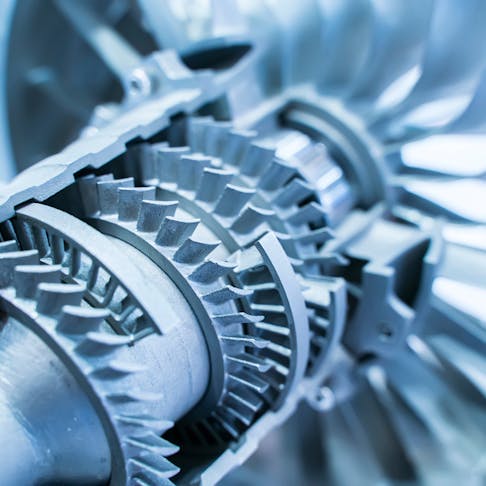It’s no small feat to get a plane into the air, and before a pilot can even maneuver it through the sky, it needs all the right parts, components, and functioning systems in place. Building an aircraft is complex, but as technology advances, many processes are simplified, automated, and improved, and one futuristic-sounding operation, in particular, is lightening the load for engineers and manufacturers: 3D printing.
There are many ways in which additive manufacturing is making the future brighter for the world of aircraft creation, but we’ve broken down some of the most impressive and impactful ways in the article below and included services and resources Xometry has available for manufacturing aerospace and defense parts for your own company.
1. It Simplifies Plane Parts
Plane parts are typically complex and involve multiple components coming together without fault, which can be a tricky thing to achieve. With 3D printing, these parts can be turned into one streamlined design that’s materialized by a 3D printer. That means the process of getting flight parts is easier and there’s a lower risk of failure. If you’re in this sector, you can get instant and confidential quotes for flight parts through Xometry, too.
2. It Makes for Faster Production
Rather than waiting on a specific manufacturer to fix or deliver a part or suffer through long wait times, 3D printing makes it easy to print components on demand and do so all in one place. This drastically cuts down on lead times, makes it far easier to take care of urgent repairs and maintenance problems, and simplifies the prototyping process.
3. It Reduces the Weight of Plane Parts
Passengers, pilots, and manufacturers are all very familiar with the importance weight has on an aircraft’s performance and fuel efficiency. While cargo and luggage are a part of that, one of the most crucial ways that weight can be cut down is through building lighter components — something 3D printing utterly excels at. With a printer, you can construct flight parts made of plastic polymers, lighter metals, or other lightweight materials that are better optimized and not nearly as heavy as traditional structures, doors, or engines.

4. It Betters Aircraft Design
With more traditional manufacturing methods, it’s not always possible to create innovative and novel designs or test out inventive new ideas, but with 3D printing, the world of engineering has completely expanded. Not only can we create parts that are more aerodynamic and better functioning, but there’s room to trial unique new designs such as sleek turbines or stylized cabin interiors. As you can see in the image below, this is an example of what a 3D-printed airplane part looks like.
5. It Boosts and Improves the Supply Chain
The metaphorical headache caused by long lead times and complex logistics can be nearly eliminated with the help of 3D printers. Companies will no longer have to lean on extra-long chains and the hold-ups caused by one supplier or manufacturer that cause a domino effect of problems. Printing happens on demand with additive manufacturing, so parts can be made in-house and whenever needed — meaning there’s no longer a reason to store parts in enormous inventory warehouses or wait around for something to be made. It also gives back some control to your own supply chain, which is always a bonus for the folks who run aircraft companies.
6. It Cuts Down on Supply Chain Costs
It’s no secret that the costs to build an aircraft are astronomical, especially custom parts and larger commercial planes. Fortunately, this is another area where 3D printing can make a positive impact by cutting down expenses. Parts of the overall cost include transportation, tooling, storage, and inventory management — most of which can be cut out or cut down through additive manufacturing. There is also a lot of money lost through obsolete parts, but with on-demand printing, this problem will be a rarity since designs can constantly change and parts won’t have to be physically stored.

A 3D Printed Aircraft Part
The Future of 3D Printing in the Aircraft World
Additive manufacturing has already benefitted many industries, including the medical and automotive fields, and aviation is just one more branch it can support. Other ways you’ll see 3D printing impacting this world are through the development of cost-effective and fuel-efficient parts and by building with more eco-friendly materials. There is also much less wastage with this type of printing and consolidation of parts, so the sustainability aspect can really shine through.
3D printing can even improve the safety of parts, which is done by building with polymers and composites with better wear and heat resistance and longer-lasting durability. It’s also easier to make prototypes, so parts can be tested more often and more quickly than usual. Even more exciting is the fact that many of the industry's biggest players are already on board and using these technologies, including Airbus, Boeing, Lockheed Martin, GE Aviation, and Rolls-Royce, and they’re focusing extensively on using industrial-scale printers to build turbine blade, fuel nozzles, ducts, structural components, and cabin brackets.
How Xometry Can Help
Xometry has services that are extremely applicable to the aerospace and aircraft industry, including 3D printing and an entire library of 3D printing design guides. We even have an entire section dedicated to manufacturing help for the aerospace and defense industries, providing companies with the services and connections they need. Get your instant quote today.
Disclaimer
The content appearing on this webpage is for informational purposes only. Xometry makes no representation or warranty of any kind, be it expressed or implied, as to the accuracy, completeness, or validity of the information. Any performance parameters, geometric tolerances, specific design features, quality and types of materials, or processes should not be inferred to represent what will be delivered by third-party suppliers or manufacturers through Xometry’s network. Buyers seeking quotes for parts are responsible for defining the specific requirements for those parts. Please refer to our terms and conditions for more information.


